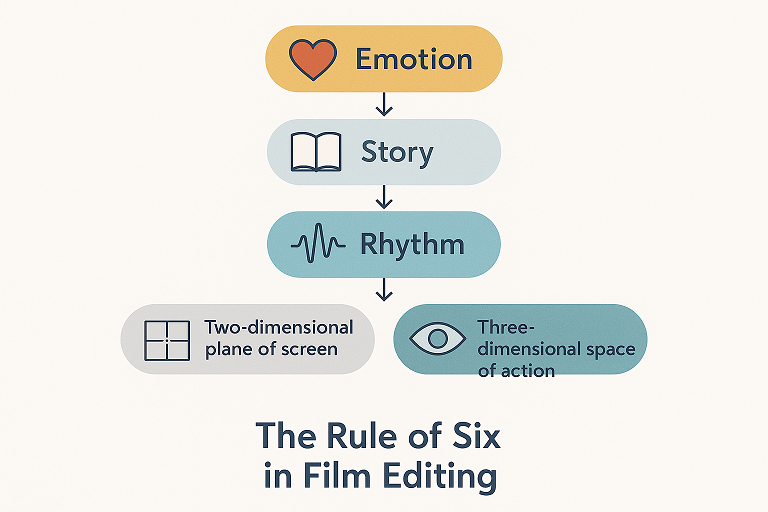Understanding the Rule of Six and Its Impact on Film Editing
The Rule of Six stands as one of the most widely referenced frameworks in film editing, guiding editors and storytellers to make thoughtful choices with each cut. Crafted by Walter Murch, the Murch principles have helped set a benchmark for every transition, ensuring every edit serves not just the rhythm or style, but first and foremost, the story.
The Murch rule puts emotion, story, rhythm, eye-trace, plane of screen, and three-dimensional space in a clear order of priority. By putting these principles in practice, editors craft films that feel cohesive, immersing audiences in a compelling cinematic experience. Let’s look closer at how the Rule of Six shapes the art of editing and why it matters for every story.
How the Rule of Six Helps Shape a Compelling Story
Applying the Rule of Six profoundly changes the way an editor approaches film editing, shifting the focus from mere technical precision to the heartbeat of the story itself. The first of the Murch principles, emotion, makes up the foundation: a cut must always prioritize what the audience should feel in that moment. If the emotion doesn’t ring true, no amount of technical perfection will serve the overall narrative. That’s what sets the Rule of Six apart from other editing guidelines; it isn’t just about smooth transitions or matching action, but about ensuring every cut advances the purpose of the story.
Within this framework, story comes directly after emotion. Each cut should strengthen the clarity and direction of the narrative, guiding the viewer’s attention without distraction. The Murch rule explicitly ranks story as the second-most important principle, reminding editors that a technically impressive cut means little if it disrupts narrative flow. Rhythm, eye-trace, two-dimensional plane, and three-dimensional space follow in order, building on an emotional and storytelling foundation. When approaching an edit, I focus on whether a scene’s cut supports the story’s arc, often referencing the Murch rule to assess whether a transition serves its purpose.
By consistently applying these priorities, editors avoid making arbitrary decisions and instead work with intention. Every cut, every transition, is weighed against the emotional and narrative goals of the film. As a professional video editor, I’ve seen first-hand how the deliberate application of the Rule of Six leads to more meaningful edits and a seamless audience experience, all while using the established rule as a trusted compass.
The Role of the Film Editor in Applying the Rule of Six
As a film editor or video editing agency, your responsibility goes far beyond piecing together footage, it’s about shaping the very heart of the story. The Rule of Six offers a practical framework for making those tough decisions, especially when it comes to executing what we call a story cut. By keeping the rule in mind, a film editor isn’t just matching shots or syncing dialogue; they’re constantly evaluating whether each edit upholds the emotional and narrative intent established earlier in the process. This method grounds editing choices in story relevance, which means that each transition should always move the story forward while maintaining its emotional truth.
In practice, the film editor acts as both a technician and a storyteller, balancing the instinctual with the analytical. The rule helps guide every story cut, ensuring that moments flow naturally and keep viewers engaged. I find the process is never simply about what looks smooth on the timeline, it’s about checking if each cut serves the bigger picture. When you weigh your decisions by the rule, you build edits that protect the integrity of your story and resonate deeply with your audience.
The film editor’s instinct for timing, rhythm, and performance is sharpened by the continual application of the Rule of Six. It becomes second nature to pause, ask if a cut is truly necessary, and question if that edit strengthens the heartbeat of the story. A rule like this offers clarity when creative choices feel overwhelming, especially under tight deadlines or when collaborating with directors whose vision hinges on powerful storytelling. Ultimately, the thoughtful use of story cuts, made in alignment with this rule, sets apart effective editing, helping the editor transform raw footage into a compelling narrative journey.
Balancing Emotion and Technique to Perfect the Cut
Perfecting a cut is all about striking the right balance between the emotional core of a scene and the technical subtleties that keep visual storytelling compelling. While the Rule of Six emphasizes emotion and story as top priorities, mastering the craft involves more than just understanding their hierarchy, it’s about weaving these elements seamlessly. Ask whether the timing and placement of a cut will reinforce the emotional arc or unexpectedly disrupt it. Sometimes, a technically flawless cut can inadvertently stifle the story’s momentum, while a slightly imperfect edit, if it’s rich in feeling, can actually enhance the film’s resonance with the audience.
Visual storytelling thrives on intentional choices. For instance, when I review footage, I’m not just looking for continuity or clean action; I’m constantly evaluating whether a cut amplifies the intended emotion or deepens the story’s clarity. Often, this means overriding the urge to always choose the neatest or most logical cut. Instead, I focus on how each transition makes the viewer feel, and whether it advances the story’s journey. It’s this interplay between gut instinct and practiced technique that elevates an edit from simply functional to truly impactful.
This balancing act doesn’t just benefit the story; it sharpens your instincts as an editor. Over time, applying the Rule of Six trains you to intuitively spot when a cut risks undermining the pace or diluting the story’s meaning. Each decision, every transition and shift, is a chance to align what’s seen and felt, creating edits that breathe life into visual storytelling. Ultimately, combining heartfelt intuition with technical know-how ensures every cut serves not just the mechanics of film, but the very soul of your story.
Practical Tips for Implementing the Rule of Six in Your Workflow
Integrating the Rule of Six into your workflow when editing films isn’t about following a checklist, it’s about developing an instinct for storytelling that guides every single cut. Since previous sections explored the core priorities laid out by Murch, let’s talk about actionable ways you can apply the rule in real edits.
Start by reviewing each scene with a clear understanding of the emotional intent. Before making a cut, pause and reflect: does this transition actually serve the moment’s emotion and move the narrative forward? By making this your default habit, you’ll find yourself catching cuts that technically fit but lack emotional weight, a common slip for even experienced editors.
An essential tactic is to constantly reference the story for every major decision. As I’ve learned in countless editing sessions, it’s easy to lose sight of the bigger picture while fine-tuning technical details. I recommend regularly stepping back from the timeline, watching sequences in context, and asking if the audience will truly feel the intended impact after each cut. The rule suggests putting emotion and story at the very top, so don’t hesitate to discard a technically correct cut if it breaks the emotional flow. Trust your reactions as a viewer, not just as an editor.
Finally, communicate your application of the rule within the collaborative process. When working with directors or producers, reference the rule as a neutral framework for evaluating the structure of story cuts. This not only improves clarity in feedback sessions, but also ensures everyone understands why a particular cut was made, or changed. As you gain experience, the rule becomes less a conscious checklist and more an editorial second nature, making your workflow more intuitive while ensuring every transition genuinely serves the film’s story and audience. These habits will help you create edits that are both technically sound and emotionally resonant, using the rule as your creative compass with every cut.
Understanding and applying the Rule of Six can elevate your video editing, helping you make intentional cuts that resonate with viewers on multiple levels. By weighing each element, emotion, story, rhythm, eye trace, two-dimensional plane, and three-dimensional space, you craft edits that not only look polished, but also drive your narrative forward. Whether you’re editing your first film or refining your craft, using these principles will lead to sequences that are compelling and meaningful, ultimately enriching the viewer’s experience and maximizing the impact of your storytelling.






